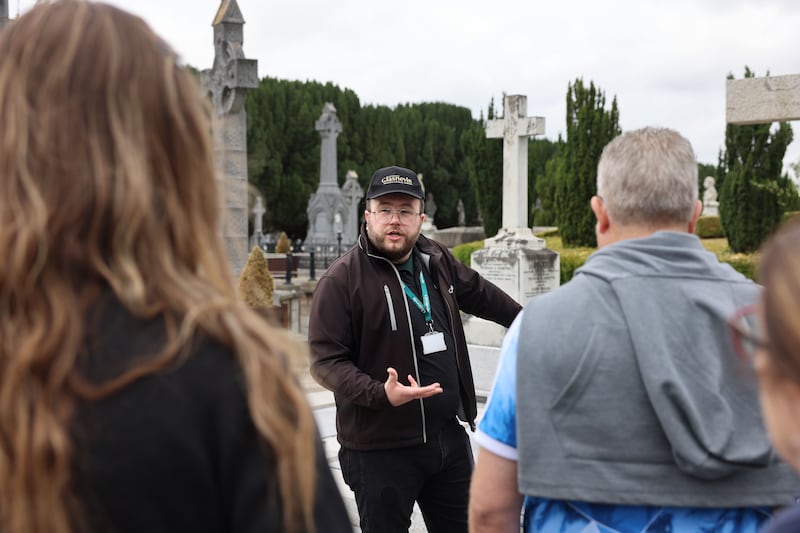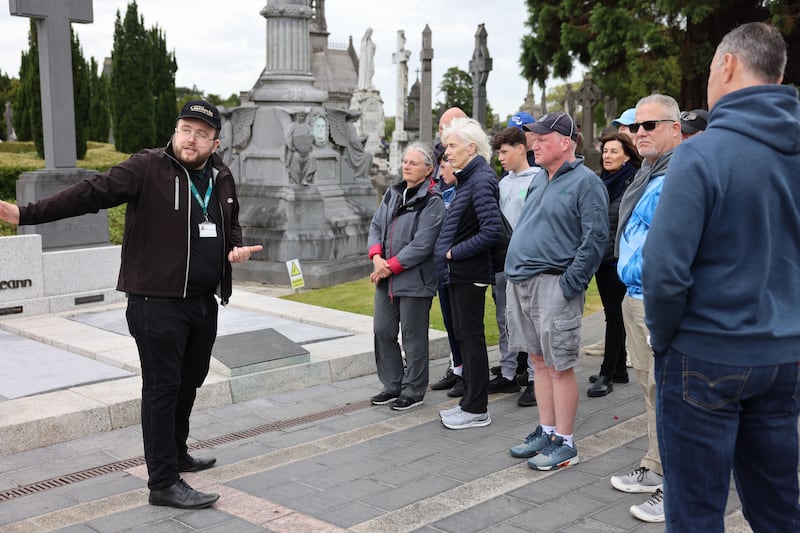I studied history and Irish at UCD, where I was active in the drama society too. There’s a pretty well-established “theatre kid to tour guide” pipeline, and I got my first tour-guiding job doing walking tours in Dublin. I heard about the opening in Glasnevin Cemetery in 2019.
I’m a bit of a “nepo baby” in that I have some relation to Daniel O’Connell, who founded the cemetery in 1832. He is buried here as well. I grew up not far from the O’Connell home, Derrynane House. We always knew we had some connection to him, and recently enough, my Dad pinpointed that he is my second cousin, seven times removed. Our common ancestor is Captain John O’Connell, who fought for King James II against William of Orange in 1690. I definitely feel a connection to Daniel O’Connell, as distant as it might be.
Glasnevin runs the gamut of historical figures – you’ve got Charles Stewart Parnell, Roger Casement, Éamon de Valera, Michael Collins – those were the names I knew coming into this job. Working here, you get a real sense of the number of ordinary people buried here too, which makes it a really special place. There are over 1.5 million people buried here – there are only 1.4 million alive in Dublin.
One of the really special things I’ve learned is just how revolutionary the place was from the beginning. Daniel O’Connell started the cemetery in reaction to restrictions in the Penal Laws against how Catholics could bury their dead. But he didn’t want it to be just for Catholics. From the beginning, it was a place for all religions and none. There are about 26 different religious traditions here, and many [occupants] with no religion as well.
READ MORE
It would have been the only cemetery in Ireland for quite a long period that would have buried those who died by suicide, or unbaptised children. There are no separate sections, everyone is equal at the very end.
There are so many regular Dubliners here, and everybody is accounted for. Even if they couldn’t afford a headstone, people are not forgotten. They survive in our records – not just their name and address, but their occupation and cause of death. We have Dublin zookeepers here who were killed by zoo animals. Every tour guide has their own spin on the tour.
Unsurprisingly, given my surname, Daniel O’Connell never gets old for me. I could talk about Daniel O’Connell all day because of the progressive spirit in which he founded the cemetery. He was one of Europe’s most prominent voices for the abolition of slavery. There would have been people in slaveholding areas of America who were sympathetic to his cause trying to give him money, but he refused. He stood up for Aborigines too in the decades after the colonisation of Australia.

There was no expense spared on his grave – they pulled out all the stops. His crypt is underneath the round tower. It would have been based on the towers in the old monasteries, like Glendalough and Clonmacnoise. It’s a symbol of the golden age of Ireland. He’s in a resplendent altar tomb; his coffin is inside this wonderful intricate carved sandstone sarcophagus. There is all this Celtic revivalist art on the walls of the tomb, which is fitting, because he sparked the idea of Irish nationalist identity. He gave people a sense of control of their destiny. The views from the top of the tower are incredible.
‘When I talk about Éamon de Valera for example and how much he extends into the modern era, I say that he and Snoop Dogg were alive at the same time’
You get a 360-degree view of the cemetery, we’re one of the biggest in Europe, over 120 acres in size. On a clear day you can see the Cooley Mountains in Louth. The tower survived a bombing during the Troubles in 1971. There were about 10lb of gelignite hidden inside a biscuit tin. Nobody claimed responsibility for it, but it’s thought to have been loyalists getting revenge for the bombing of Nelson’s Pillar in 1966. We reopened the tower in 2018 and we’ve recently put in a brand new exhibition.
Glasnevin was founded as a Victorian garden cemetery. The idea was that this is not just a place to mourn, it’s a green space in which to walk and admire the statuary too. We are right next to the Botanic Gardens, so you have a bigger variety of plant life here as a result. Something you have to be very aware of on tours is that we are still a working cemetery. We have funerals six days a week. For some people this is the worst day of their lives, and you have to be respectful of that.

You have to be aware of people’s different views as well. People have this sense of the place as being this Valhalla for nationalist figures, but there are other viewpoints here as well. There are two brothers on opposite sides of the Easter Rising buried here. I’ve a great-grandfather buried here who had two sons fighting in the first World War while the Easter Rising was going on, so there are different elements at play. To be a good tour guide you have to tell people something that they already know, something they don’t know, something to make them laugh, and something that will make them cry. If you’ve done all that, you’ve done your job.
When I talk about Éamon de Valera for example and how much he extends into the modern era, I say that he and Snoop Dogg were alive at the same time. Obscure details about well-known people can make people think about history differently. Being a tour guide satisfies so many different parts of me. I feel honoured and privileged to work here.





















